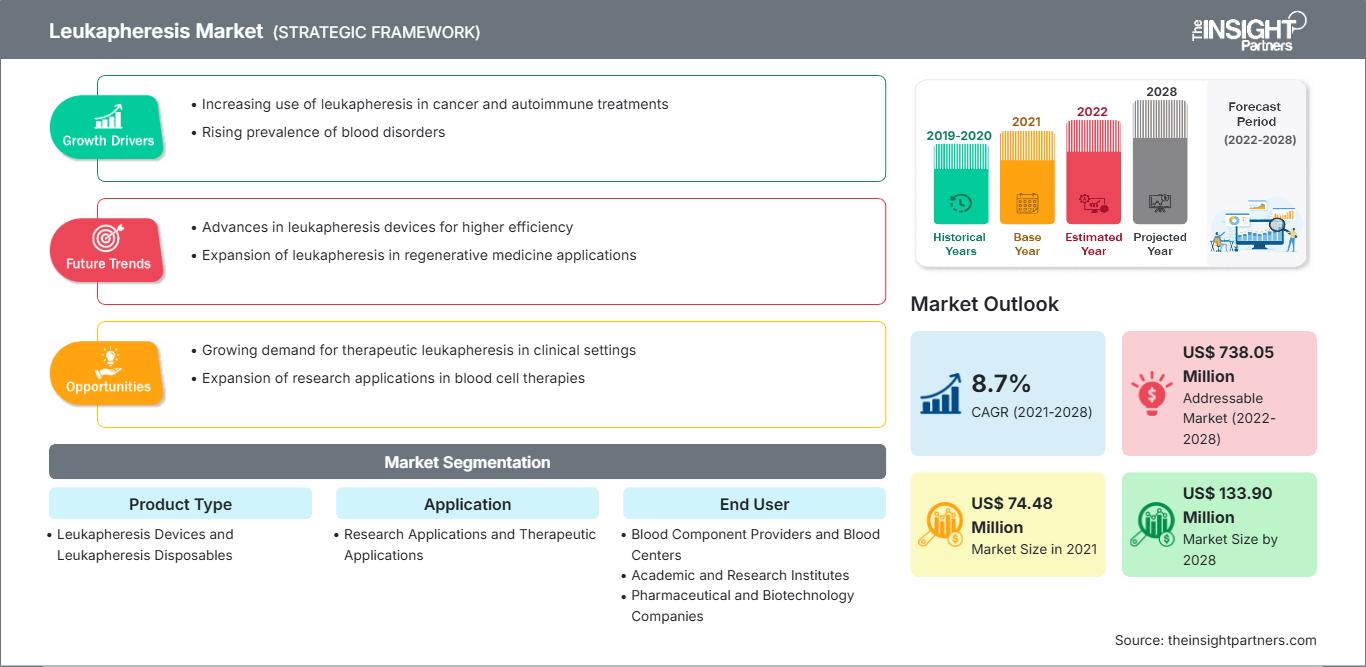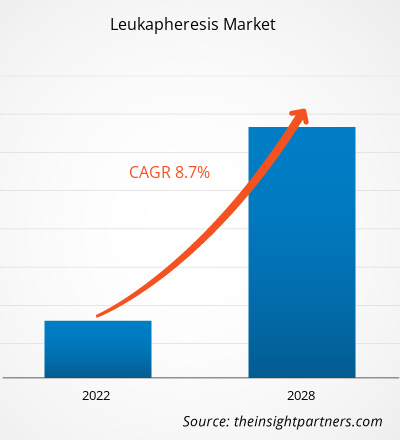[Informe de investigación] Se proyecta que el mercado de leucocitaféresis alcance los 133,90 millones de dólares estadounidenses en 2028, desde los 74,48 millones de dólares estadounidenses en 2021; se estima que crecerá a una CAGR del 8,7 % entre 2021 y 2028.
La leucocitaféresis es un procedimiento que separa de una muestra de sangre los glóbulos blancos (leucocitos) que participan en la respuesta inmunitaria del organismo. Se trata de una forma particular de aféresis en la que se obtiene un componente de la sangre, como glóbulos rojos o plaquetas, mientras que el resto se reintroduce en la circulación. La leucocitaféresis se utiliza a menudo para reducir los recuentos muy altos de glóbulos blancos (GB), como en cánceres sanguíneos crónicos como la leucemia linfocítica crónica (LLC). También se puede realizar para obtener glóbulos blancos para un trasplante posterior, por ejemplo, para controlar descensos bruscos en los recuentos de GB durante la quimioterapia oncológica. Otro uso es como parte de una nueva forma de inmunoterapia, denominada terapia de células T con receptores de antígenos quiméricos (CAR), para ayudar a combatir la leucemia, el cáncer de próstata y otros tipos de cáncer. La leucocitaféresis se puede realizar en la persona que solicita el tratamiento (aféresis autóloga) o en un donante para un trasplante posterior (aféresis alogénica). Actualmente, la leucoféresis se utiliza comúnmente para tratar diversas enfermedades y también con fines diagnósticos, ya que puede aumentar la producción de células tumorales circulantes. Factores como el creciente número de donantes voluntarios de sangre, la creciente incidencia de enfermedades hematológicas y el aumento de la población de edad avanzada impulsan el crecimiento del mercado de la leucoféresis. Sin embargo, el alto costo de la leucoféresis obstaculiza en cierta medida su crecimiento.
Obtendrá personalización en cualquier informe, sin cargo, incluidas partes de este informe o análisis a nivel de país, paquete de datos de Excel, así como también grandes ofertas y descuentos para empresas emergentes y universidades.
Mercado de leucocitaféresis: perspectivas estratégicas

-
Obtenga las principales tendencias clave del mercado de este informe.Esta muestra GRATUITA incluirá análisis de datos, desde tendencias del mercado hasta estimaciones y pronósticos.
Perspectivas del mercado
La transfusión sanguínea es parte integral de la infraestructura y las políticas sanitarias nacionales de varios países. Los avances en la industria médica han impulsado mejoras en los procedimientos de tratamiento de enfermedades y lesiones graves, lo que finalmente ha impulsado la necesidad de transfusiones sanguíneas para la supervivencia de los pacientes. La creciente conciencia sobre la importancia de las transfusiones sanguíneas y su disponibilidad en los servicios de salud ha llevado a un aumento en el número de personas dispuestas a donar sangre por causas médicas. Según datos de la Organización Mundial de la Salud (OMS), en 2018 se reportaron aproximadamente 117,4 millones de donaciones de sangre en todo el mundo. Los donantes de sangre generalmente se clasifican en voluntarios no remunerados, remunerados y familiares/de reemplazo, y según la OMS, los donantes voluntarios/no remunerados son la principal fuente de un suministro de sangre confiable y adecuado. Según datos de la OMS en 2019, las donaciones de sangre de donantes voluntarios no remunerados aumentaron en 11,6 millones entre 2008 y 2015 en 139 países del mundo. La tendencia de la donación de sangre también está cobrando importancia en los países de ingresos bajos y medios. Según los datos presentados durante la reunión anual del CAG de 2017, en 2016 se realizaron aproximadamente 13 000 procedimientos a 1087 pacientes. El mayor aumento en el número de donantes voluntarios de sangre se registró en los países del Sudeste Asiático (83 %) y las Américas (70 %).
Los programas nacionales desarrollados e implementados en muchos países están atrayendo a un gran número de donantes de plaquetas y sangre. Por ejemplo, en India, el Consejo Nacional de Transfusión Sanguínea (NBTC), constituido dentro de la Organización Nacional para el Control del SIDA (NACO), es el organismo central que coordina con los Consejos Estatales de Transfusión Sanguínea (SBTC), establecidos dentro de las Sociedades Estatales para el Control del SIDA (SACS). El NBTC apoya programas de salud para diversas actividades relacionadas con los servicios de transfusión sanguínea (STS). Por lo tanto, el creciente número de donantes elegibles en diferentes países del mundo está fomentando la necesidad de equipos de leucoféresis que se utilizan para separar los componentes sanguíneos necesarios.
Información basada en el tipo de producto
Según el tipo de producto, el mercado de leucocitaféresis se divide en dispositivos y desechables. En 2021, el segmento de desechables tuvo una mayor cuota de mercado. Sin embargo, se espera que el segmento de dispositivos registre una mayor tasa de crecimiento anual compuesta (TCAC) entre 2021 y 2028.
Perspectivas basadas en aplicaciones
El mercado de la leucoféresis, por aplicación, se divide en aplicaciones de investigación y aplicaciones terapéuticas. En 2021, el segmento de aplicaciones de investigación tuvo una mayor participación de mercado y se espera que este mismo segmento registre una mayor tasa de crecimiento anual compuesta (TCAC) en los próximos años.
Información basada en el usuario final
El mercado de la leucoféresis, por usuario final, se segmenta en empresas farmacéuticas y biotecnológicas, institutos académicos y de investigación, proveedores de componentes sanguíneos y centros de sangre, y hospitales y centros de transfusión. En 2021, el segmento de proveedores de componentes sanguíneos y centros de sangre tuvo la mayor participación de mercado. Por otro lado, se espera que el segmento de hospitales y centros de transfusión registre la mayor tasa de crecimiento anual compuesta (TCAC) durante los próximos años.
Las empresas que operan en el mercado de leucocitaféresis están adoptando estrategias como lanzamientos de productos, fusiones y adquisiciones, colaboraciones, innovaciones de productos y expansiones de carteras de productos para expandir su presencia en todo el mundo, mantener la marca y satisfacer la creciente demanda de los usuarios finales.
Perspectivas regionales del mercado de leucocitaféresis
Los analistas de The Insight Partners han explicado detalladamente las tendencias regionales y los factores que influyen en el mercado de la leucocitaféresis durante el período de pronóstico. Esta sección también analiza los segmentos y la geografía del mercado de la leucocitaféresis en América del Norte, Europa, Asia Pacífico, Oriente Medio y África, y América del Sur y Central.
Alcance del informe de mercado de leucocitaféresis
| Atributo del informe | Detalles |
|---|---|
| Tamaño del mercado en 2021 | US$ 74,48 millones |
| Tamaño del mercado en 2028 | US$ 133,90 millones |
| CAGR global (2021-2028) | 8,7% |
| Datos históricos | 2019-2020 |
| Período de pronóstico | 2022-2028 |
| Segmentos cubiertos |
Por tipo de producto
|
| Regiones y países cubiertos |
América del norte
|
| Líderes del mercado y perfiles de empresas clave |
|
Densidad de actores del mercado de leucocitaféresis: comprensión de su impacto en la dinámica empresarial
El mercado de la leucoféresis está creciendo rápidamente, impulsado por la creciente demanda del usuario final debido a factores como la evolución de las preferencias de los consumidores, los avances tecnológicos y un mayor conocimiento de los beneficios del producto. A medida que aumenta la demanda, las empresas amplían su oferta, innovan para satisfacer las necesidades de los consumidores y aprovechan las tendencias emergentes, lo que impulsa aún más el crecimiento del mercado.

- Obtenga una descripción general de los principales actores clave del mercado de leucocitaféresis
Mercado de leucoféresis por tipo de producto
-
Dispositivos de leucocitaféresis
- Dispositivos de aféresis
- Columnas de leucoféresis y separadores celulares
- Filtros de leucorreducción
- Desechables para leucocitaféresis
Mercado de leucoféresis: por aplicación
- Aplicaciones de investigación
- Aplicaciones terapéuticas
Mercado de leucoféresis por usuario final
- Empresas farmacéuticas y biotecnológicas
- Institutos académicos y de investigación
- Proveedores de componentes sanguíneos y centros de sangre
- Hospitales y centros de transfusión
Mercado de leucoféresis por geografía
-
América del norte
- A NOSOTROS
- Canadá
- México
-
Europa
- Francia
- Alemania
- Italia
- Reino Unido
- España
- Resto de Europa
-
Asia Pacífico (APAC)
- Porcelana
- India
- Corea del Sur
- Japón
- Australia
- Resto de Asia Pacífico
-
Oriente Medio y África (MEA)
- Sudáfrica
- Arabia Saudita
- Emiratos Árabes Unidos
- Resto de Oriente Medio y África
-
América del Sur (SAM)
- Brasil
- Argentina
- Resto de América del Sur y Central
Perfiles de empresas
- Corporación Asahi Kasei
- Fresenius SE & Co. KGaA
- Corporación Haemonetics
- Corporación Terumo
- Tecnologías STEMCELL Inc.
- HemaCare
- Macopharma
- Todas las celdas
- STEMEXPRESS
- BioIVT
- Análisis histórico (2 años), año base, pronóstico (7 años) con CAGR
- Análisis PEST y FODA
- Tamaño del mercado, valor/volumen: global, regional y nacional
- Industria y panorama competitivo
- Conjunto de datos de Excel
Informes recientes
Testimonios
Razón para comprar
- Toma de decisiones informada
- Comprensión de la dinámica del mercado
- Análisis competitivo
- Información sobre clientes
- Pronósticos del mercado
- Mitigación de riesgos
- Planificación estratégica
- Justificación de la inversión
- Identificación de mercados emergentes
- Mejora de las estrategias de marketing
- Impulso de la eficiencia operativa
- Alineación con las tendencias regulatorias






















 Obtenga una muestra gratuita para - Mercado de leucoféresis
Obtenga una muestra gratuita para - Mercado de leucoféresis